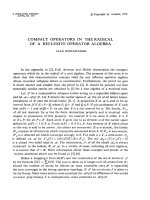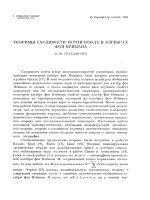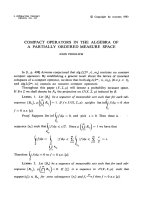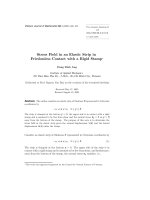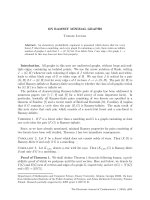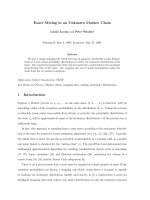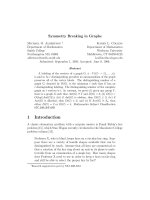Báo cáo toán học: "Degree powers in graphs with forbidden subgraphs" docx
Bạn đang xem bản rút gọn của tài liệu. Xem và tải ngay bản đầy đủ của tài liệu tại đây (95.45 KB, 8 trang )
Degree powers in graphs with forbidden subgraphs
B´ela Bollob´as
∗†‡
and Vladimir Nikiforov
∗
Submitted: Jan 27, 2004; Accepted: Jun 10, 2004; Published: Jun 25, 2004
MR Subject Classifications: 05C35
Abstract
For every real p>0 and simple graph G, set
f (p, G)=
u∈V (G)
d
p
(u) ,
and let φ (r, p, n) be the maximum of f (p, G) taken over all K
r+1
-free graphs G of
order n. We prove that, if 0 <p<r,then
φ (r, p, n)=f (p, T
r
(n)) ,
where T
r
(n)isther-partite Turan graph of order n. For every p ≥ r +
√
2r
and
n large, we show that
φ (p, n, r) > (1 + ε) f (p, T
r
(n))
for some ε = ε (r) > 0.
Our results settle two conjectures of Caro and Yuster.
1 Introduction
Our notation and terminology are standard (see, e.g. [1]).
Caro and Yuster [3] introduced and investigated the function
f (p, G)=
u∈V (G)
d
p
(u) ,
where p ≥ 1 is integer and G is a graph. Writing φ (r, p, n) for the maximum value of
f (p, G) taken over all K
r+1
-free graphs G of order n, Caro and Yuster stated that, for
every p ≥ 1,
φ (r, p, n)=f (p, T
r
(n)) , (1)
∗
Department of Mathematical Sciences, University of Memphis, Memphis TN 38152, USA
†
Trinity College, Cambridge CB2 1TQ, UK
‡
Research supported in part by DARPA grant F33615-01-C-1900.
the electronic journal of combinatorics 11 (2004), #R42 1
where T
r
(n)isther-partite Tur´an graph of order n. Although true for p =2,r≥ 2,
simple examples show that (1) fails for every fixed r ≥ 2 and all sufficiently large p and n;
this was observed by Schelp [4]. A natural problem arises: given r ≥ 2, determine those
real values p>0, for which equality (1) holds. Furthermore, determine the asymptotic
value of φ (r, p, n) for large n.
In this note we essentially answer these questions. In Section 2 we prove that (1)
holds whenever 0 <p<rand n is large. Next, in Section 3, we describe the asymptotic
structure of K
r+1
-free graphs G of order n such that f (p, G)=φ (r, p, n) . We deduce
that, if p ≥ r +
√
2r
and n is large, then
φ (r, p, n) > (1 + ε) f (p, T
r
(n))
for some ε = ε (r) > 0. This disproves Conjecture 6.2 in [3]. In particular,
r
pe
≥
φ (r, p, n)
n
p+1
≥
r −1
(p +1)e
holds for large n, and therefore, for any fixed r ≥ 2,
lim
n→∞
φ (r, p, n)
f (p, T
r
(n))
grows exponentially in p.
The case r = 2 is considered in detail in Section 4; we show that, if r =2, equality
(1) holds for 0 <p≤ 3, and is false for every p>3andn large.
In Section 5 we extend the above setup. For a fixed (r + 1)-chromatic graph H,
(r ≥ 2) , let φ (H, p, n) be the maximum value of f (p, G) taken over all H-free graphs G
of order n. It turns out that, for every r and p,
φ (H, p, n)=φ (r, p, n)+o
n
p+1
. (2)
This result completely settles, with the proper changes, Conjecture 6.1 of [3]. In fact,
Pikhurko [5] proved this for p ≥ 1, although he incorrectly assumed that (1) holds for all
sufficiently large n.
2 The function φ (r, p, n) for p<r
In this section we shall prove the following theorem.
Theorem 1 For every r ≥ 2, 0 <p<r,and sufficiently large n,
φ (r, p, n)=f (p, T
r
(n)) .
Proof Erd˝os [2] proved that, for every K
r+1
-free graph G, there exists an r-partite graph
H with V (H)=V (G) such that d
G
(u) ≤ d
H
(u) for every u ∈ V (G). As Caro and Yuster
the electronic journal of combinatorics 11 (2004), #R42 2
noticed, this implies that, for K
r+1
-free graphs G of order n, if f (p, G) attains a maximum
then G is a complete r-partite graph. Every complete r-partite graph is defined uniquely
by the size of its vertex classes, that is, by a vector (n
i
)
r
1
of positive integers satisfying
n
1
+ + n
r
= n; note that the Tur´an graph T
r
(n) is uniquely characterized by the
condition |n
i
− n
j
|≤1 for every i, j ∈ [r] . Thus we have
φ (r, p, n)=max
r
i=1
n
i
(n − n
i
)
p
: n
1
+ + n
r
= n, 1 ≤ n
1
≤ ≤ n
r
. (3)
Let (n
i
)
r
1
be a vector on which the value of φ (r, p, n) is attained. Routine calculations
show that the function x (n − x)
p
increases for 0 ≤ x ≤
n
p+1
, decreases for
n
p+1
≤ x ≤ n,
and is concave for 0 ≤ x ≤
2n
p+1
. If n
r
≤
2n
p+1
, the concavity of x (n −x)
p
implies that
n
r
−n
1
≤ 1, and the proof is completed, so we shall assume n
r
>
2n
p+1
. Hence we deduce
n
1
(r −1) +
2n
p +1
<n
1
+ + n
r
= n. (4)
We shall also assume
n
1
≥
n
p +1
, (5)
since otherwise, adding 1 to n
r
and subtracting 1 from n
1
, the value
r
i=1
n
i
(n − n
i
)
p
will increase, contradicting the choice of (n
i
)
r
1
. Notice that, as n
1
≤ n/r, inequality (5) is
enough to prove the assertion for p ≤ r −1 and every n. From (4) and (5), we obtain that
(r −1)
n
p +1
+
2n
p +1
<n.
Letting n →∞, we see that p ≥ r, contradicting the assumption and completing the
proof. ✷
Maximizing independently each summand in (3), we see that, for every r ≥ 2and
p>0,
φ (r, p, n) ≤
r
p +1
p
p +1
p
n
p+1
. (6)
3 The asymptotics of φ (r, p, n)
In this section we find the asymptotic structure of K
r+1
-free graphs G of order n satisfying
f (p, G)=φ (r, p, n) , and deduce asymptotic bounds on φ (r, p, n) .
Theorem 2 For al l r ≥ 2 and p>0, there exists c = c (p, r) such that the following
assertion holds.
If f (p, G)=φ (r, p, n) for some K
r+1
-free graph G of order n, then G is a complete
r-partite graph having r −1 vertex classes of size cn + o (n) .
the electronic journal of combinatorics 11 (2004), #R42 3
Proof We already know that G is a complete r-partite graph; let n
1
≤ ≤ n
r
be the
sizes of its vertex classes and, for every i ∈ [r] , set y
i
= n
i
/n. It is easy to see that
φ (r, p, n)=ψ (r, p) n
p+1
+ o
n
p+1
,
where the function ψ (r, p) is defined as
ψ (r, p)=max
r
i=1
x
i
(1 − x
i
)
p
: x
1
+ + x
r
=1, 0 ≤ x
1
≤ ≤ x
r
We shall show that if the above maximum is attained at (x
i
)
r
1
, then x
1
= =
x
r−1
. Indeed, the function x (1 − x)
p
is concave for 0 ≤ x ≤ 2/ (p +1), and convex for
2/ (p +1) ≤ x ≤ 1. Hence, there is at most one x
i
in the interval (2/ (p +1) ≤ x ≤ 1],
which can only be x
r
. Thus x
1
, , x
r−1
are all in the interval [0, 2/ (p +1)], and so, by
the concavity of x (1 −x)
p
, they are equal. We conclude that, if
0 ≤ x
1
≤ ≤ x
r
,x
1
+ + x
r
=1,
and x
j
>x
i
for some 1 ≤ i<j≤ r − 1, then
r
i=1
x
i
(1 − x
i
)
p
is below its maximum
value. Applying this conclusion to the numbers (y
i
)
r
1
, we deduce the assertion of the
theorem. ✷
Set
g (r, p, x)=(r −1) x (1 − x)
p
+(1− (r −1) x)(rx)
p
.
From the previous theorem it follows that
ψ (r, p)= max
0≤x≤1/(r−1)
g (r, p, x) .
Finding ψ (r, p) is not easy when p>r.In fact, for some p>r,there exist 0 <x<y<1
such that
ψ (r, p)=g (r, p, x)=g (r, p, y) .
In view of the original claim concerning (1), it is somewhat surprising, that for p>
2r − 1, the point x =1/r, corresponding to the Tur´an graph, not only fails to be a
maximum of g (r, p, x), but, in fact, is a local minimum.
Observe that
f (p, T
r
(n))
n
p+1
=
r −1
r
p
+ o (1) ,
so, to find for which p the function φ (r, p, n) is significantly greater than f (p, T
r
(n)), we
shall compare ψ (r, p)to
r−1
r
p
.
Theorem 3 Let r ≥ 2,p≥ r +
√
2r
. Then
ψ (r, p) > (1 + ε)
r −1
r
p
for some ε = ε (r) > 0.
the electronic journal of combinatorics 11 (2004), #R42 4
Proof We have
ψ (r, p) ≥ g
r, p,
1
p
=
r −1
p
p − 1
p
p
+
1 −
r −1
p
r −1
p
p
>
r −1
p
p − 1
p
p
.
To prove the theorem, it suffices to show that
r −1
p
(p − 1) r
p (r −1)
p
> 1+ε (7)
for some ε = ε (r) > 0. Routine calculations show that
r −1
p
1+
p − r
p (r −1)
p
increases with p. Thus, setting q =
√
2r
, we find that
r −1
p
1+
p − r
p (r −1)
p
≥
r −1
r + q
1+
r + q
1
q
(r + q)(r −1)
+
r + q
2
q
2
(r + q)
2
(r −1)
2
=
r −1
r + q
+
q
r + q
+
q
2
(r + q −1)
2(r + q)
2
(r −1)
≥ 1 −
1
r + q
+
r (r + q −1)
(r + q)
2
(r −1)
=1+
r (r + q −1) − (r + q)(r −1)
(r + q)
2
(r −1)
=1+
q
(r + q)
2
(r −1)
.
Hence, (7) holds with
ε =
√
2r
r +
√
2r
2
(r −1)
,
completing the proof. ✷
We have, for n sufficiently large,
φ (r, p, n)
n
p+1
= ψ (r, p)+o (1) ≥ g
r, p,
1
p +1
+ o (1)
=
r −1
p +1
p
p +1
p
+
1 −
r −1
p +1
r −1
p +1
p
+ o (1)
>
r −1
p +1
p
p +1
p
.
Hence, in view of (6), we find that, for n large,
r
pe
≥
r
p
p
p +1
p+1
≥
φ (r, p, n)
n
p+1
≥
r −1
p +1
p
p +1
p
≥
(r −1)
(p +1)e
.
the electronic journal of combinatorics 11 (2004), #R42 5
In particular, we deduce that, for any fixed r ≥ 2,
lim
n→∞
φ (r, p, n)
f (p, T
r
(n))
grows exponentially in p.
4 Triangle-free graphs
For triangle-free graphs, i.e., r = 2, we are able to pinpoint the value of p for which (1)
fails, as stated in the following theorem.
Theorem 4 If 0 <p≤ 3 then
φ (3,p,n)=f (p, T
2
(n)) . (8)
For every ε>0, there exists δ such that if p>3+δ then
φ (3,p,n) > (1 + ε) f (p, T
2
(n)) (9)
for n sufficiently large.
Proof We start by proving (8). From the proof of Theorem 1 we know that
φ (p, n, 3) = max
k∈n/2
{k (n −k)
p
+(n − k) k
p
}.
Our goal is to prove that the above maximum is attained at k = n/2.
If 0 <p≤ 2, the function x (1 −x)
p
is concave, and (8) follows immediately.
Next, assume that 2 <p≤ 3; we claim that the function
g (x)=(1+x)(1− x)
p
+(1−x)(1+x)
p
is concave for |x|≤1. Indeed, we have
g (x)=
1 − x
2
(1 − x)
p−1
+(1+x)
p−1
=2
1 − x
2
∞
i=0
p − 1
2i
x
2i
=2+2
∞
i=1
p − 1
2i
−
p − 1
2i − 2
x
2i
=2+2
∞
i=1
p − 1
2i − 2
(p − 2i − 1) (p − 2i − 2)
(2i − 1) 2i
− 1
x
2i
.
Since, for every i, the coefficient of x
2i
is nonpositive, the function g (x)isconcave,as
claimed.
the electronic journal of combinatorics 11 (2004), #R42 6
Therefore, the function h (x)=x (n − x)
p
+(n − x) x
p
is concave for 1 ≤ x ≤ n.
Hence, for every integer k ∈ [n] , we have
h
n
2
+ h
n
2
≥ h (k)+h (n − k)=2h (k)
=2(k (n − k)
p
+(n − k) k
p
) ,
proving (8).
Inequality (9) follows easily, since, in fact, for every p>3, the function g (x)hasa
local minimum at 0. ✷
5 H-free graphs
In this section we are going to prove the following theorem.
Theorem 5 For every r ≥ 2, and p>0,
φ (H, p, n)=φ (r, p, n)+o
n
p+1
.
A few words about this theorem seem in place. As already noted, Pikhurko [5] proved
the assertion for p ≥ 1; although he incorrectly assumed that (1) holds for all p and
sufficiently large n, his proof is valid, since it is independent of the exact value of φ (r, p, n) .
Our proof is close to Pikhurko’s, and is given only for the sake of completeness.
We shall need the following theorem (for a proof see, e.g., [1], Theorem 33, p. 132).
Theorem 6 Suppose H is an (r +1)-chromatic graph. Every H-free graph G of suffi-
ciently large order n can be made K
r+1
-free by removing o (n
2
) edges.
ProofofTheorem5Select a K
r+1
-free graph G of order n such that f (p, G)=
φ (r, p, n) . Since G is r-partite, it is H-free, so we have φ (H, p, n) ≥ φ (r, p, n) . Let
now G be an H-free graph of order n such that
f (p, G)=φ (H, p, n) .
Theorem 6 implies that there exists a K
r+1
-free graph F that may be obtained from
G by removing at most o (n
2
) edges. Obviously, we have
e (G)=e (F )+o
n
2
≤
r −1
2r
n
2
+ o
n
2
.
For 0 <p≤ 1, by Jensen’s inequality, we have
1
n
f (p, G)
1/p
≤
1
n
f (1,G)=
1
n
2e (G) ≤
r −1
r
n + o (n) .
the electronic journal of combinatorics 11 (2004), #R42 7
Hence, we find that
f (p, G) ≤
r −1
r
p
n
p+1
+ o
n
p+1
= φ (r, p, n)+o
n
p+1
,
completing the proof.
Next, assume that p>1. Since the function xn
p−1
− x
p
is decreasing for 0 ≤ x ≤ n,
we find that
d
p
G
(u) − d
p
F
(u) ≤ (d
G
(u) − d
F
(u)) n
p−1
for every u ∈ V (G) . Summing this inequality for all u ∈ V (G), we obtain
f (p, G) ≤ f (p, F )+(d
G
(u) − d
F
(u)) n
p−1
= f (p, F )+o
n
p+1
≤ φ (r, p, n)+o
n
p+1
,
completing the proof. ✷
6 Concluding remarks
It seems interesting to find, for each r ≥ 3, the minimum p for which the equality (1) is
essentially false for n large. Computer calculations show that this value is roughly 4.9 for
r =3, and 6.2 for r = 4, suggesting that the answer might not be easy.
References
[1] B. Bollob´as, Modern Graph Theory, Graduate Texts in Mathematics, 184, Springer-
Verlag, New York (1998), xiv+394 pp.
[2] P. Erd˝os, On the graph theorem of Tur´an (in Hungarian), Mat. Lapok 21 (1970),
249–251.
[3] Y. Caro and R. Yuster, A Tur´an type problem concerning the powers of the degrees
ofagraph,Electron. J. Comb. 7 (2000), RP 47.
[4] R. H. Schelp, review in Math. Reviews, MR1785143 (2001f:05085), 2001.
[5] O. Pikhurko, Remarks on a Paper of Y. Caro and R. Yuster on Tur´an problem,
preprint, arXiv:math.CO/0101235v1 29 Jan 2001.
the electronic journal of combinatorics 11 (2004), #R42 8
